TCL P755 stands out primarily due to its Google TV system, which simplifies daily use of the television. It is easy to operate, runs smoothly, and provides access to numerous applications, while personalised recommendations help quickly find something to watch. Support for AirPlay and Windows Miracast allows for easy casting from other devices. All of this makes the television a good option as a home entertainment centre. When it comes to picture quality, P755 offers solid performance for its price. Dolby Vision makes HDR content look better – colours are vibrant and contrast sharper. The wide colour gamut results in an image that is rich and natural, which is evident when watching films. Additionally, the television has a high native contrast, which distinguishes it in this price range. For gamers, the P755 could also be an interesting option. Low input lag enables smooth gameplay, and games run responsively. Of course, the 60 Hz panel does not provide ideal fluidity, and the HGiG function does not work perfectly, but for occasional gaming, this model is adequate. However, it does come with some drawbacks. Low brightness means that the image in bright rooms may be less readable, and the viewing angles are quite average. Dithering can also be an issue, causing artefacts in darker scenes, especially when using the television as a monitor – the fonts on the screen are less legible. TCL P755 is a good choice for those looking for an affordable television with features. Dolby Vision, a wide colour gamut, and low input lag are the strengths of this model. Although brightness and viewing angles could be better, it offers a lot at this price and works well for everyday viewing or occasional gaming.
- Matching (Score)
- Our verdict
- TV appearance
- Where to buy
- Contrast and black detail
- HDR effect quality
- Factory color reproduction
- Color reproduction after calibration
- Smoothness of tonal transitions
- Image scaling and smoothness of tonal transitions
- Blur and motion smoothness
- Console compatibility and gaming features
- Input lag
- Compatibility with PC
- Viewing angles
- TV efficiency during daytime
- Details about the matrix
- TV features
- Apps
- Playing files from USB
- Sound
TCL P755 vs PHILPS PUS9060
Direct compare
P755
The One 2025 / PUS9060 / PUS9000

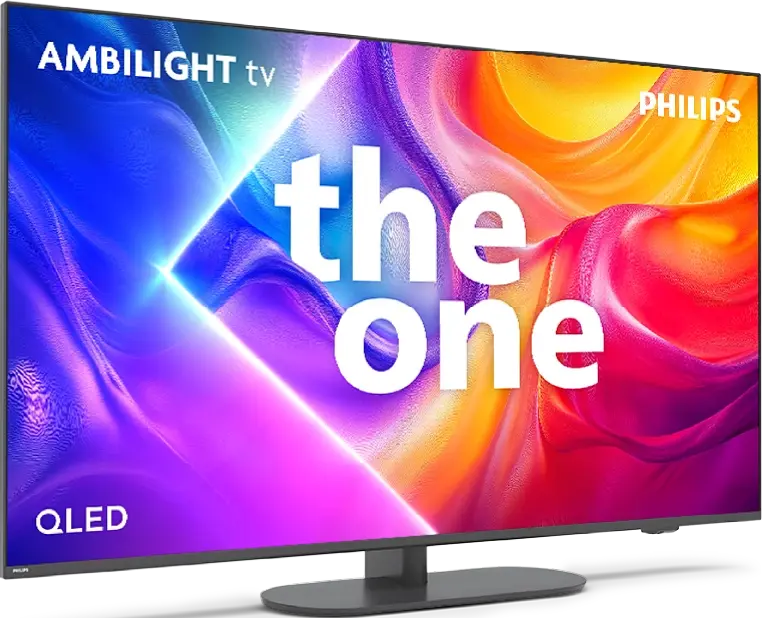
Panel type: LCD VA
Resolution: 3840x2160
System: Google TV
Model year: 2024
Complete the survey to find out the result

Panel type: LCD VA
Resolution: 3840x2160
System: Titan OS
Model year: 2025
Complete the survey to find out the result

Overall rating
5.8
6.8
Movies and series in UHD quality
5.8
6.7
Classic TV, YouTube
6.0
6.5
Sports broadcasts (TV and apps)
5.1
6.6
Gaming on console
6.8
8.4
TV as a computer monitor
2.5
8.8
Watching in bright light
3.8
6.0
Utility functions
7.7
6.4
Apps
9.6
6.2
Sound quality
5.8
6.6
Complete the survey to find out what fits your preferences
Advantages
High native contrast
Support for advanced features for gamers
Advanced Google TV operating system
Low input lag
Support for all HDR formats
Support for all Dolby and DTS audio formats
VA matrix with very good native contrast
Ambilight TV system, which enhances perceived contrast
Support for dynamic HDR formats: Dolby Vision and HDR10+
Great for gamers: 4K 120/144 Hz support, VRR, ALLM, HGiG, G-Sync Compatible
Low input lag
Very good compatibility with PCs
Support for multiple audio formats - Dolby Atmos and DTS
Illuminated remote control with numeric keypad
Disadvantages
Low brightness
Average viewing angles
Incorrectly functioning HGiG mode
Poor font readability
The Titan OS operating system can be underdeveloped
Limited number of applications
Average viewing angles
Lack of television functions (Recording to USB, PIP, Audio-only mode)
Infrared remote control (must be aimed at the screen)
Our verdict
Philips PUS9000 is proof that the manufacturer not only keeps a finger on the pulse but also listens attentively to its users. In the latest iteration of this popular series, there is a noticeable progress – especially compared to the previous generation that we had the opportunity to test. The use of a VA panel has brought a significant improvement in black levels, which finally presents itself at an acceptable level. A brightness of 500 nits does not disappoint even in sunlit rooms, and support for a wide range of HDR formats – including Dolby Vision and HDR10+ – complements the image of a well-prepared device. Additionally, the support for spatial audio technologies such as Dolby Atmos and DTS only enhances the positive impression, especially since the presence of all the aforementioned formats is not a given, even in the priciest models of 2025. But what truly sets this model apart from the competition is the Ambilight system. The multicoloured backlighting not only makes a visual impression – in a darkened room, it can enhance perceived contrast and completely transform the experience of watching a film or series. The gaming mode also deserves recognition. 144 Hz, low input lag, variable refresh rate, G-Sync compatibility, and Game Bar function – everything one could expect from a device designed with consoles and PC in mind. Unfortunately, not everything works perfectly. The Titan OS system, while operating relatively smoothly, still suffers from shortcomings – many popular applications are lacking, minor bugs appear, and the overall experience can be somewhat clunky in everyday use. Moreover, the remote, despite its modern appearance, still uses infrared and requires aiming at the television. What a pity.
So, who is the PUS9060 for? For those who want to immerse themselves in an evening session with impressive Ambilight, game on consoles, and stream content from external devices. In such a scenario, “The One” may indeed turn out to be "the one" – especially since its price is not off-putting on release day.
TV appearance




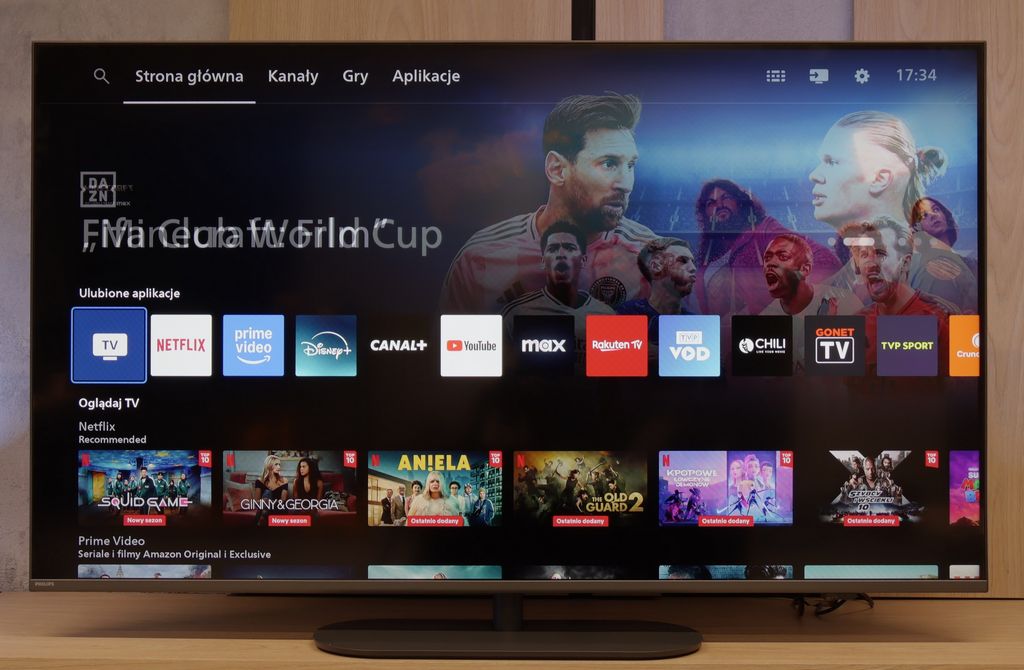
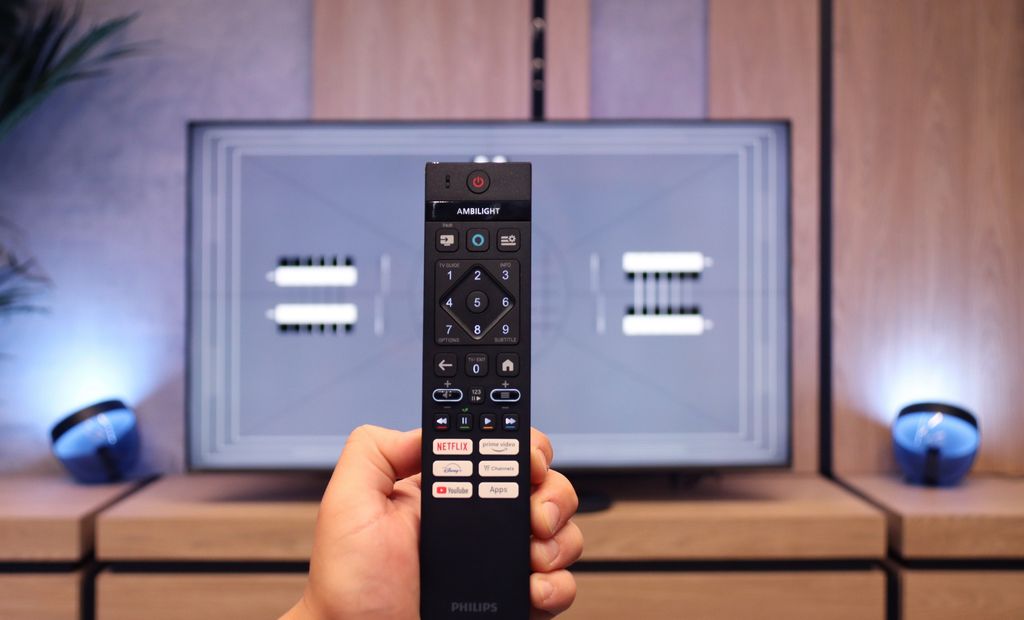

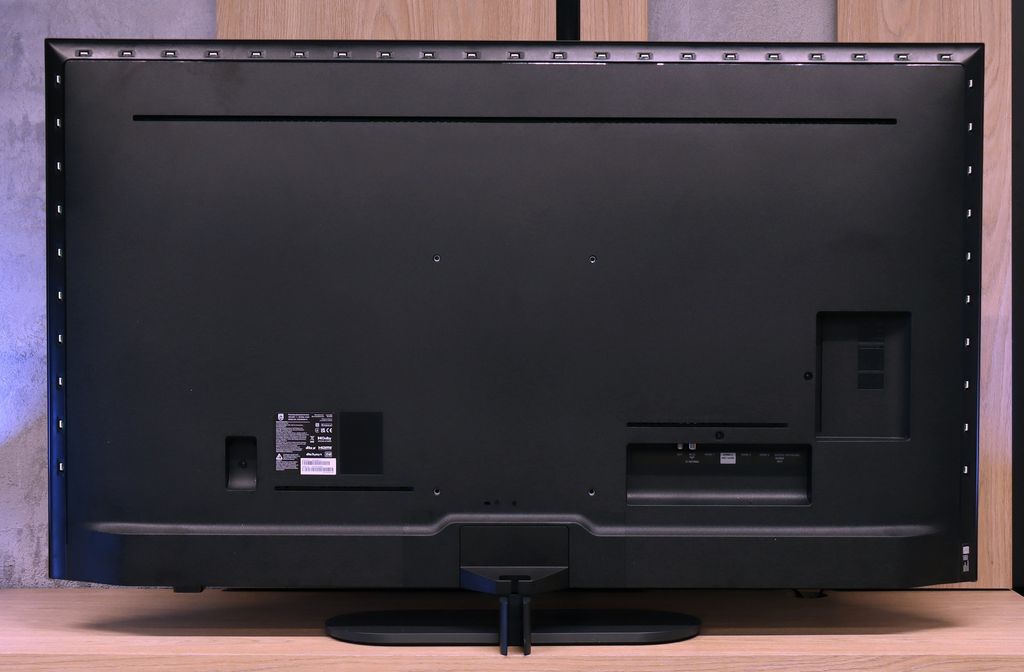
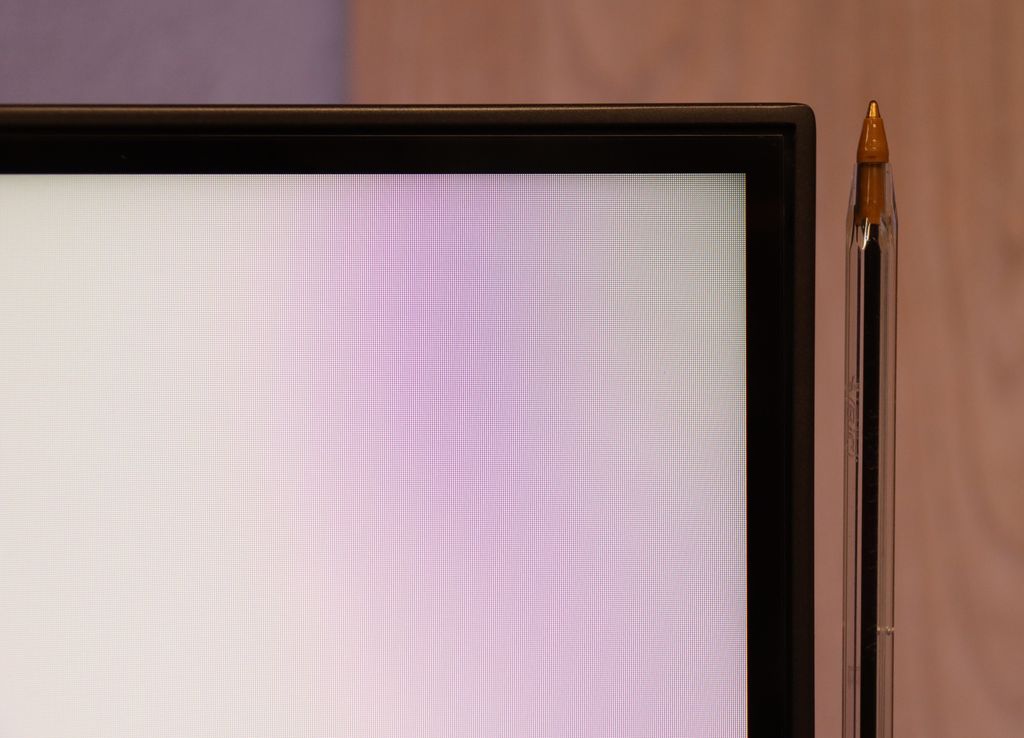
Contrast and black detail
6.1/10
6.2/10
Local dimming function: No
Local dimming function: No
Contrast:

Result
5,650:1

Result
6,750:1

Result
5,850:1

Result
6,550:1

Result
6,100:1

Result
6,000:1

Result
6,750:1

Result
7,300:1

Result
6,000:1

Result
6,800:1
Halo effect and black detail visibility:

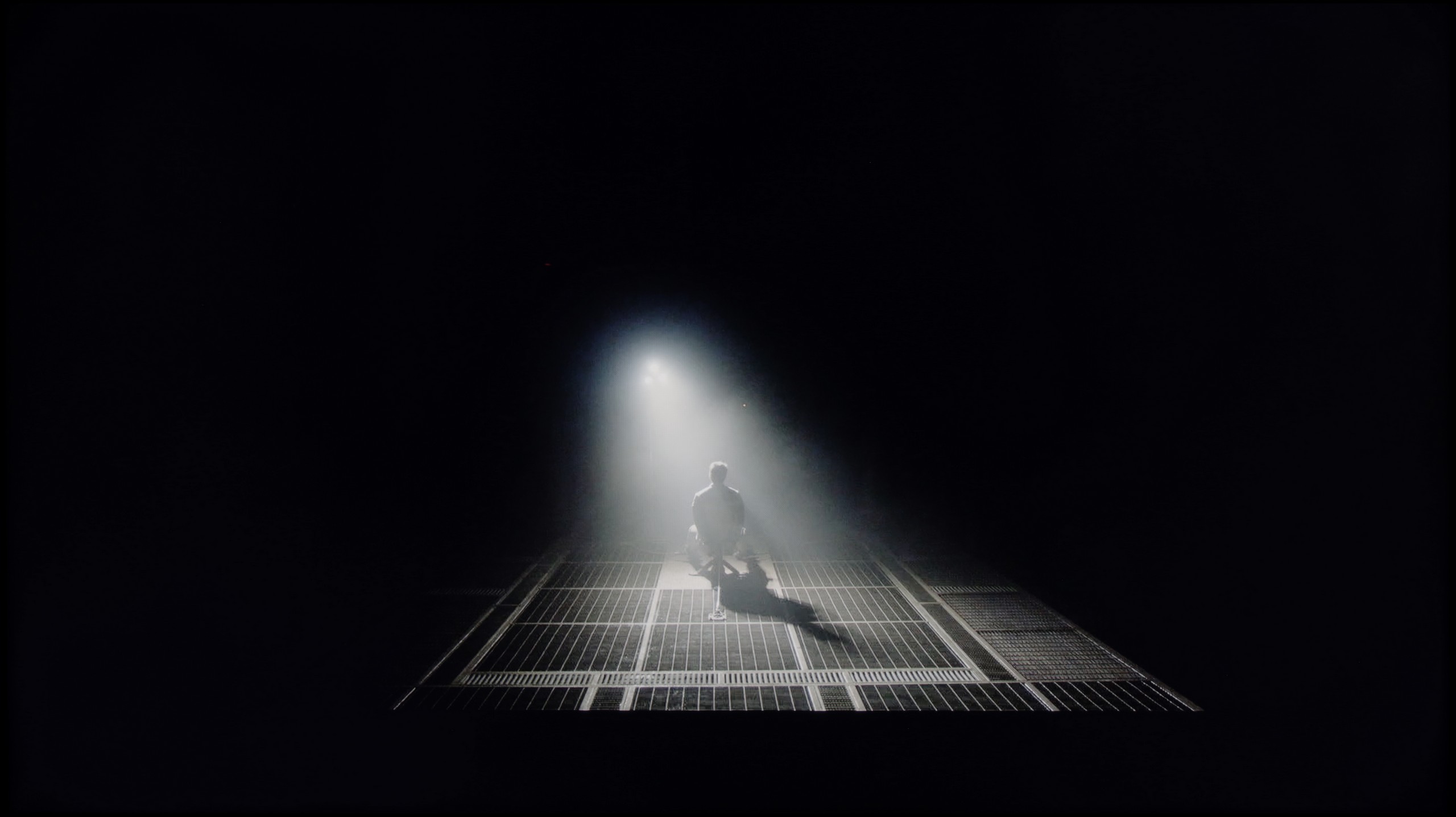
TCL P755, equipped with a VA panel, offers very high contrast, which translates to deeper blacks and better detail representation in darker scenes than in the case of IPS/ADS panels. The panel in this model has an exceptionally high native contrast. In film mode, contrast is a strong point of the television, but the lack of local dimming technology means that blacks are not perfectly deep. They often take on shades of navy, which can be particularly noticeable in dark movie scenes. During the test with the film Sicario 2 , certain flaws were also noted in the form of uneven backlighting, which can distract from important details in the blacks, lowering the overall immersion in the scenes. However, it should be remembered that this comment refers to the sample we tested; nonetheless, it is worth bearing in mind that similar shortcomings may occur in other units.
The PUS9060 is a television that, in this version, is equipped with a VA panel – and this is immediately evident in the contrast tests. In the tested images, the television achieved really good results, at around 6500:1. Such a result alone indicates that the television has a very decent black level. Unfortunately, the PUS9060 is not equipped with local dimming technology, and as a result, the black levels in the dark may appear to have a tint resembling navy blue. Fortunately, the The One series is known, among other things, for the famous Ambilight system, which significantly improves perceived contrast, and thus ‘tricks’ our eye into seeing a better black level. It may seem simple, but it is remarkably useful. Therefore, we recommend using this television in the evening with this system switched on. It doesn’t necessarily have to be multicoloured and track the picture – it can simply be white.
HDR effect quality
4/10
5.7/10
Luminance measurements in HDR:

Result
190 nit

Result
238 nit

Result
272 nit

Result
248 nit

Result
283 nit

Result
507 nit

Result
430 nit

Result
542 nit

Result
551 nit

Result
545 nit
Scene from the movie “Pan” (about 2800 nits)


Scene from the movie “Billy Lynn” (about 1100 nits)


Static HDR10


Dynamic: Dolby Vision
Dynamic: Dolby Vision


HDR luminance chart:
PHILPS PUS9060
Luminancja HDR
Luminance of RGB colors
TCL P755
Luminancja HDR
Luminance of RGB colors
TCL P755 provides average HDR effect quality. The maximum brightness of the television is slightly below 300 nits. Such brightness limits the intensity of bright areas in HDR content. In practice, this means that bright elements may not be sufficiently pronounced, which affects the overall impression of contrast. However, the television offers a wide coverage of the DCI P3 colour gamut, reaching around 93%. As a result, colours are vibrant and saturated, significantly improving colour reproduction quality in HDR content. Despite the limited brightness, the wide colour range allows for richer and more realistic shades.
The One is bright enough to enjoy films recorded in HDR format. The average brightness of this model is around 500 nits, so we can easily expect a pleasant viewing experience for films from streaming platforms. Of course – it could always be better, because when it comes to brightness, you can never have too much for this type of content. Unfortunately, a disappointing surprise may be the coverage of the DCI-P3 colour palette offered by the PUS9060. Although the manufacturer boasts about using a QLED filter here (in reality, it’s PFS LED), it's hard to speak of any positive effects from its operation. 85% coverage of the DCI-P3 palette is certainly not a level to be proud of in 2025 – particularly in a television advertised as QLED.
Factory color reproduction
6.2/10
5.5/10


Factory Mode
After calibration


Factory Mode
After calibration
The colour reproduction in the P755 in "Movie" mode, although it is the best factory setting, leaves much to be desired. The biggest problem is the white balance, where the graph clearly shows a spike in red and a drop in green. This leads to a shift in colours towards red, making the colours on the screen less natural and potentially looking incorrect, especially in scenes with a white or neutral background. This is confirmed by the "Colour Checker" test, which reveals that the colours are indeed skewed towards red, affecting the realism of the image and reducing the perception of colour depth. In terms of contrast, the gamma chart analysis shows considerable fluctuations, particularly in dark areas of the image, where values drop below the optimal level of 2.4. This results in darker areas being displayed brighter than they should be. Additionally, the EOTF curve, responsible for brightness reproduction, is slightly above the reference curve. The graph shows a slight boost in brightness to around 50%, followed by only a minor decrease. This leads to excessive brightness enhancement in the mid-tones of the image and may result in loss of detail and distortion in brighter scenes.
We tested the PUS9060 in the best factory mode available – of course, we are referring to the movie mode. Unfortunately, the best in this case does not mean good. The image in this mode was distinctly yellowish and shifted towards orange tones. The white balance on this television was definitely too warm, giving the entire scene an artificial, somewhat “tanned” appearance. This led to significant colour errors, which in the worst cases exceeded a delta E value of 6 – thus they were visible to the naked eye. The situation was reversed in HDR mode, where the image became too blue and too cool in perception. Additionally, there was a slight increase in brightness – the gamma curve and EOTF suggested that the television slightly brightened the image, which was also evident in the comparative photo below.
Color reproduction after calibration
7.6/10
8/10




After calibration, the colour reproduction on the television improves significantly when it comes to SDR content. The colour curves are now close to the ideal value, and the gamma is more stable. Although the drop at the beginning of the graph to value is still present, the overall accuracy of colour reproduction is much better. The "Colour Checker" test shows that most colour samples have errors below level 2, indicating improved colour fidelity. A few deviations are present, but generally, the colours are now more realistic and consistent with reality.
Calibration also brings improvement in HDR content. The white balance has been improved, resulting in a more natural colour reproduction. The EOTF curve, although now closer to the reference curve, still shows a slight boost in brightness at the beginning of the graph. This leads to minor distortions in very bright scenes, but the overall tonal quality and detail have been enhanced. Dynamic tone mapping works more effectively, improving image quality in bright areas and retaining more detail.
Although the device's picture does not achieve complete perfection, calibration brings significant improvement. After adjusting the settings, the television presents itself much better, offering a more realistic and accurate colour reproduction in SDR and HDR content. While some shortcomings can still be noticed, calibration effectively eliminates many previous issues, ensuring better image quality and more natural colours.
Thanks to calibration in film mode, we managed to completely eliminate the yellow-orange tint, which significantly improved the perception of the entire scene. The image has become much more visually pleasing, although it is still far from reference settings. It may now appear slightly bluish, but it is still a definite improvement compared to the factory settings.
Unfortunately, we were not able to significantly improve the brightness characteristics, but this is already a matter of the television's design - the absence of local dimming limits the ability to precisely manage brightness. The PUS9060 simply cannot dynamically adjust luminance as more advanced models do. Nevertheless, after calibration, the overall experience is much more enjoyable, especially with film material.
Smoothness of tonal transitions
7.5/10
8.9/10












In the case of high-quality content, TCL P755 offers decent fluidity in tonal transitions. Although there are slight imperfections in colour blending, especially in more complex gradients, these are typical for televisions in this price range. During testing in filmic scenes, these issues were noticeable at certain moments, but in most cases, one really has to pay close attention to spot these flaws. For the average user, they should not pose a significant problem in everyday use.
PHILIPS PUS9060 handles tonal transitions excellently – we did not notice any serious problems with colour blending. The gradation looks natural, without unpleasant bands or harsh transitions. We could only nitpick the most challenging dark scenes – that is where minimal imperfections appear, but overall it looks quite OK, especially for the class of equipment. For most users, the effect will be more than satisfactory.
Image scaling and smoothness of tonal transitions
5.5/10
6.7/10
Smooth transition function


Image without overscan on the SD signal


The "Gradual Smoothing" function works quite well, effectively eliminating visible boundaries between different shades of the same colour. Thanks to it, tonal transitions are smoother. Unfortunately, this function is not available in HDR mode, which may affect the quality of tonal gradations in higher dynamic range materials.
When it comes to image scaling, the television does not perform at its best. There are noticeable edge cuts, particularly evident on the figure of the model and the branches of trees. The blurring of details in these areas affects the overall sharpness of the image. This may be noticeable when watching content in a lower resolution. Moreover, SD quality images are displayed with slight cropping at the top as well as the bottom.
In the PUS9060, we find yet another version of the image processor called by Philips the P5 Perfect Picture, which is designed to improve the image – especially the imperfect one. The television features a distortion reduction function, which serves to smooth tonal transitions, i.e., those "colour joins" we mentioned earlier. This function does this very effectively – there is no noticeable harsh gradation of colours, but unfortunately, it works so aggressively that it sometimes dulls desired elements, such as the textures of materials or film grain. So one can consider this a certain compromise. We would rather not recommend using this function for films, but for more casual content – e.g., YouTube or standard television – it is perfectly fine.
The P5 processor also aims to improve the quality of lower-resolution images and does so quite effectively. The test image with the model is very soft – sometimes overly so – but this can be easily adjusted with the sharpness slider to match personal preferences. It is also pleasing that the television does not cut off edges in SD materials – which unfortunately still occurs in some TV models.
Blur and motion smoothness
4.3/10
7.5/10

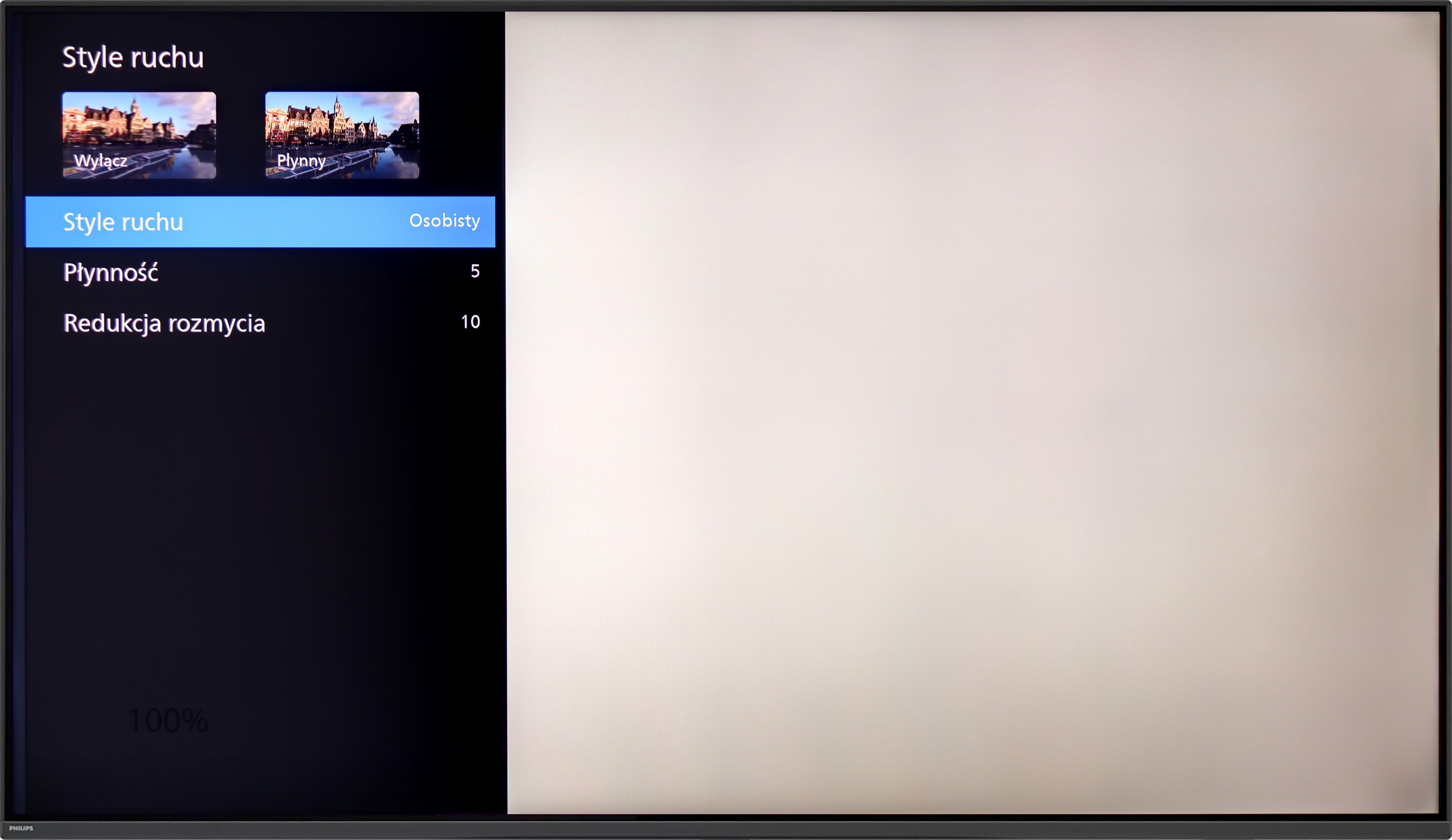
Blur (native resolution, maximum refresh rate):






The television offers decent, although not perfect, results in terms of motion fluidity. For films, the television features a “Flicker Reduction” function that allows for motion fluidity adjustment on a scale from 1 to 10. With this option, we can customise the appearance of the image to a cinematic or more theatrical preference (with a slower or faster pace).
PHILIPS PUS9060 is equipped with a 4K panel with a refresh rate of 144 Hz, so we can confidently say that it is suitable for both watching sports and playing games. And indeed, it is. But what about films that are most often recorded at 24 frames? As with most of the televisions we tested with a refresh rate of 120 Hz and above, the PUS9060 offers two sliders in the motion smoothness options. The “Smoothness” slider allows you to adjust the effect in films – you can set the image to be smoother, resembling a theatrical effect (higher settings), or more cinematic, with a slight "jump" in frame rate (lower settings). Additionally, there is a function called "Motion Blur Reduction," which limits blurring – and this is a very useful feature, especially when watching sports.
Console compatibility and gaming features
5.3/10
9.8/10
- ALLM
- VRR
- VRR range48 - 60Hz48 - 144Hz
- Dolby Vision Game Mode
- Correct implementation of HGIG
- 1080p@120Hz
- 1440p@120Hz
- 4K@120Hz
- Game bar

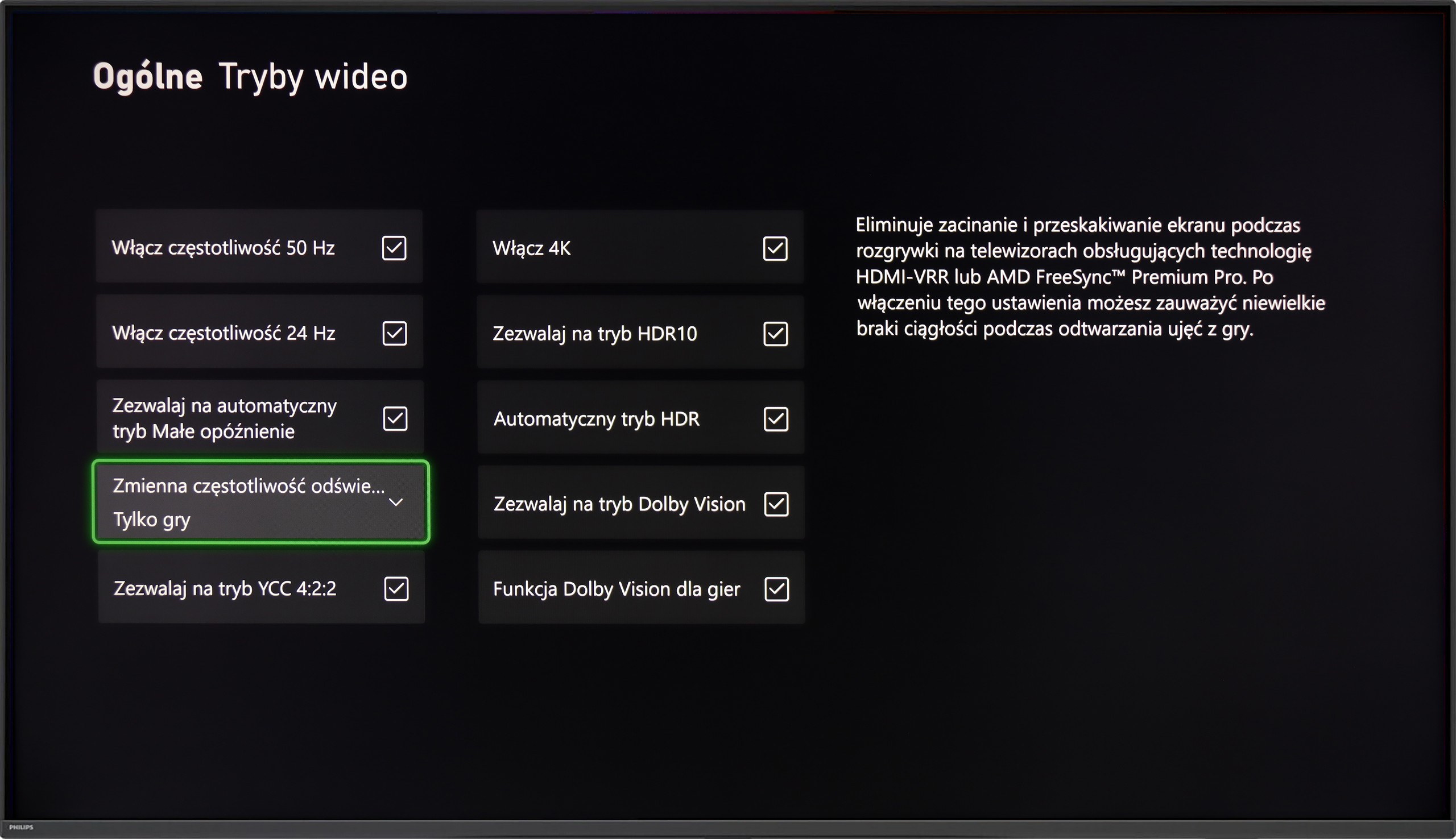



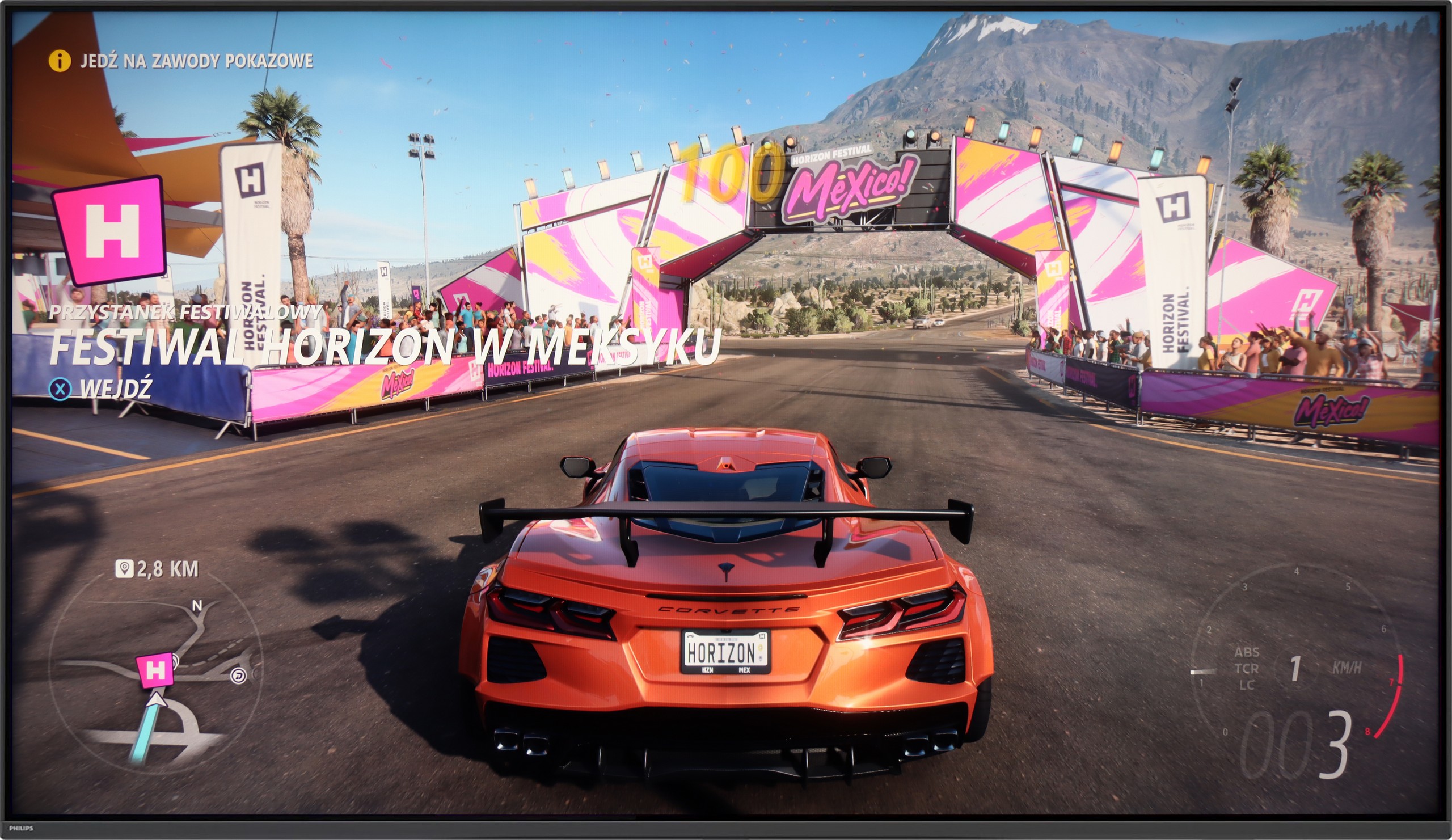

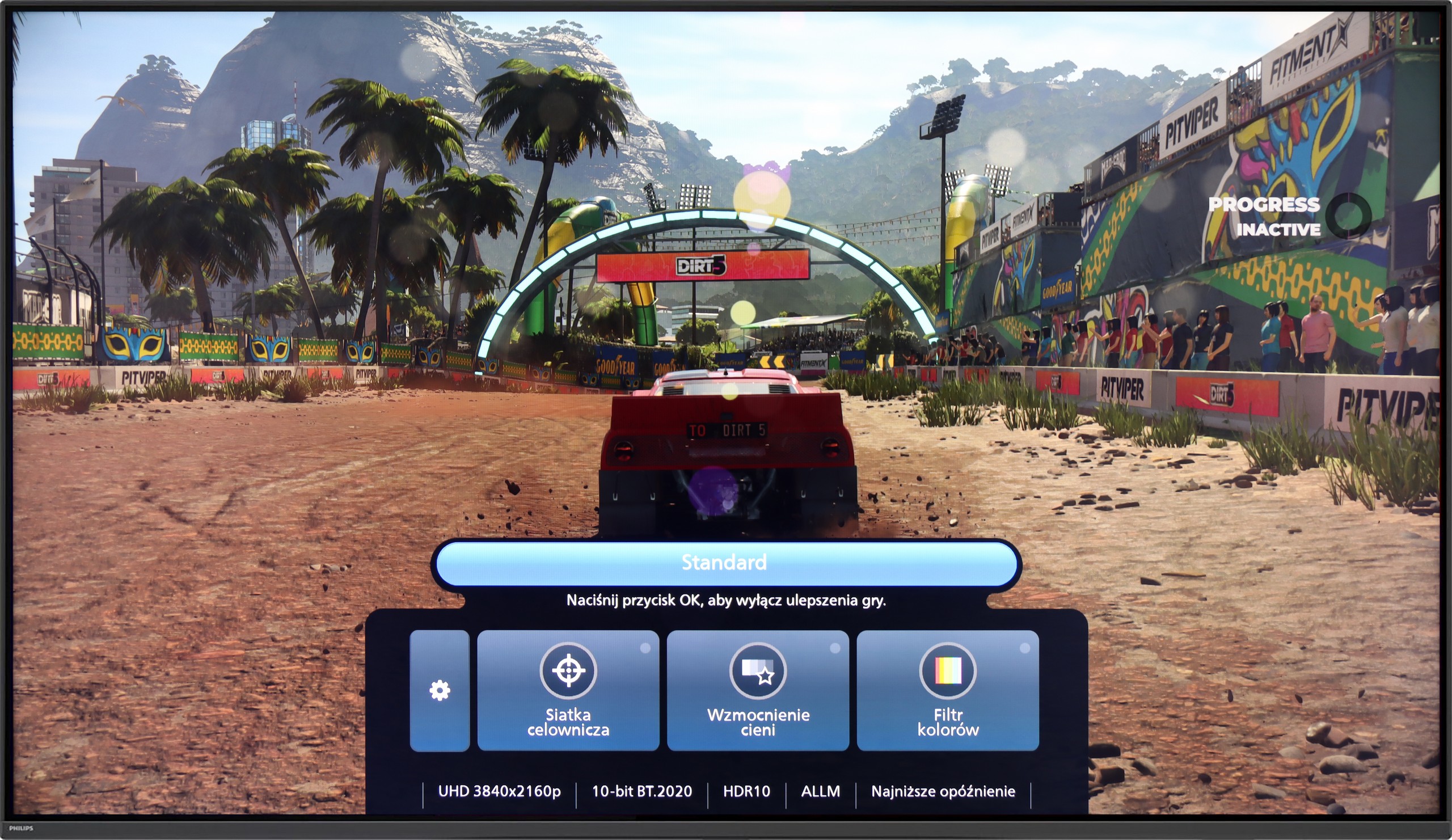
The device offers a range of features useful for gamers, such as ALLM (Auto Low Latency Mode), VRR (Variable Refresh Rate), Dolby Vision for gamers, and Game Bar. ALLM automatically switches the television to low latency mode, significantly improving response to commands from the controller and minimising input lag. VRR synchronises the screen refresh rate with the number of frames generated by the console, eliminating screen tearing and providing smoother gameplay. Dolby Vision for gamers enhances picture quality, offering better colour and contrast reproduction in games that support this format. The Game Bar feature allows quick access to game settings and monitoring of key parameters such as reaction time.
However, the television has certain limitations. The 60 Hz panel prevents the display of higher refresh rate signals at various resolutions, which may affect the smoothness of the image in dynamic games. Additionally, the lack of support for G-Sync technology for PC may impact gameplay quality on a computer. It is also worth noting that the HGiG mode, which aims to improve picture quality in HDR games, does not function correctly in this model, negatively affecting the visual experience in HDR-supported games.
PHILIPS PUS9060 is a true gaming monster – it has practically everything you could expect from a modern gaming television. There's VRR, there's ALLM, and on top of that, there's the implementation of HGiG, which helps to set HDR in games the way the developers intended. The television supports every possible resolution at 120 Hz, including 1080p, 1440p, and full 4K – so regardless of whether you're gaming on Xbox, PS5, or PC, everything works as it should. It also features a simple Game Bar, which is a special menu for gamers that allows you to quickly check if the ALLM mode is indeed working in low-latency mode.
And of course – Ambilight TV. Let’s be honest – without LED lights at the back, it’s not really a proper gaming setup. 😉 The multicoloured backlighting can really enhance the atmosphere, especially in the evening. It may not be to everyone's taste, but younger gamers will be thrilled – because it just looks impressive.
Input lag
10/10
9.5/10
SDR
HDR
Dolby Vision
P755 offers exceptionally low input lag, which is a significant advantage for gamers. In every mode, whether SDR, HDR, or Dolby Vision, the television achieves impressive performance. In every resolution, the input lag is only 11 ms, well done! Even in Dolby mode, the television maintains the same low level of latency. Thanks to these achievements, the television provides remarkable responsiveness and excellent gaming experiences, with no noticeable delays.
The One from 2025 performs very well in terms of responsiveness. An input lag of around 9 ms at a 120 Hz signal and 18 ms at 60 Hz are values that ensure a quick and smooth response to every movement of the controller. Playing even dynamic action titles or demanding e-sports games is completely comfortable. The situation is slightly worse when it comes to Dolby Vision – here the delay increases to around 33 ms. This is still an acceptable level for most “casual” gamers, but more demanding users may notice a slight slowdown in response. Therefore, in our opinion, a better choice would be the classic HDR10 mode with HGiG active. In this model, it has been implemented correctly and not only avoids delays but also eliminates potential problems with brightness and detail reproduction that sometimes occur in Dolby Vision.
Compatibility with PC
2.5/10
8.8/10

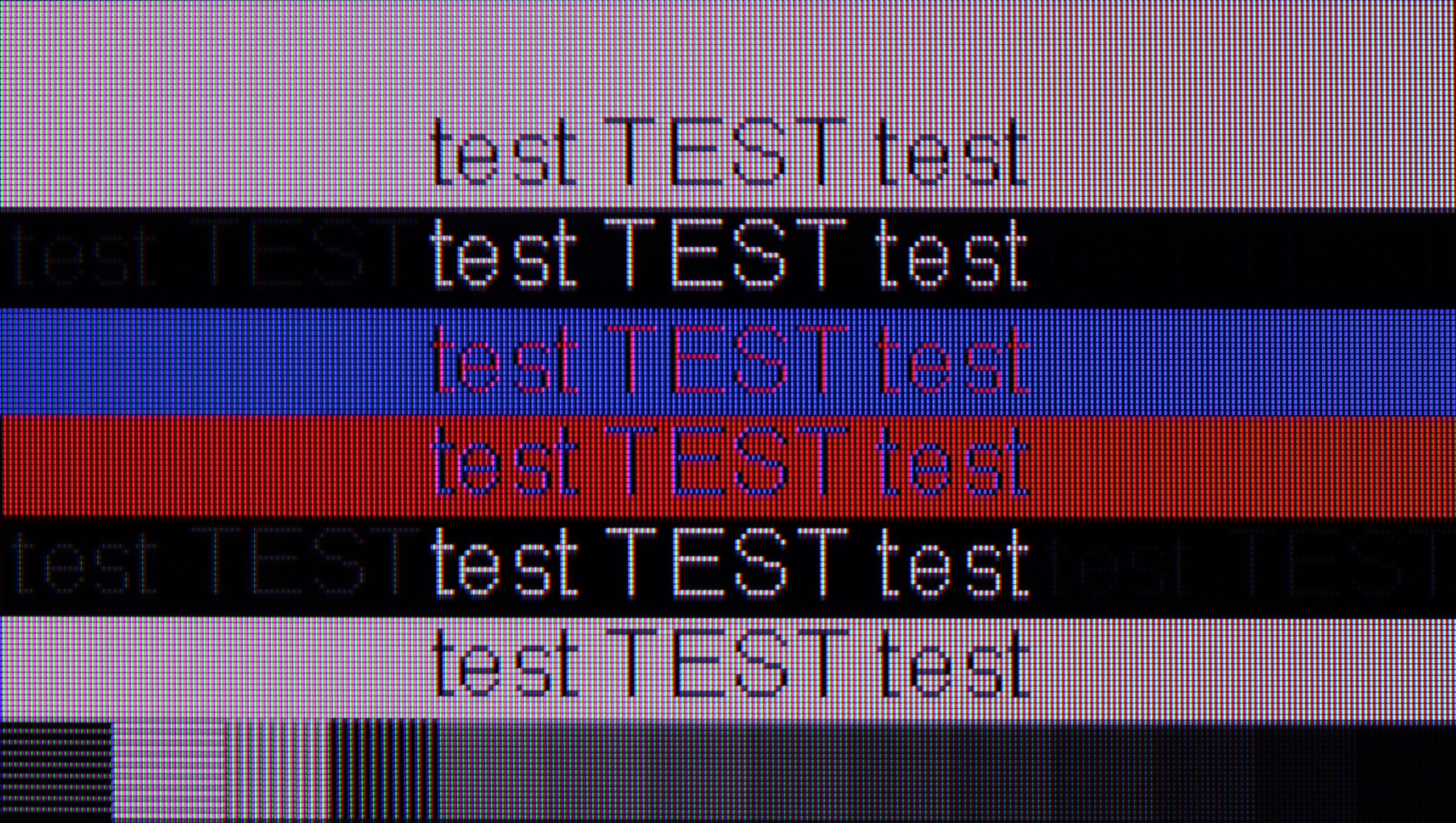
When connecting the TCL P755 to a computer, the first thing you may notice is the support for chroma 4:4:4, which ensures correct colour reproduction in details, especially when working with text and graphics. Unfortunately, despite this support, the readability of fonts leaves much to be desired, particularly with dark text and shapes on a dark background. This issue arises from the limited resolution in darker shades, where the applied dithering makes the pixels resemble those known from Full HD. This is especially visible with small fonts, making comfortable office work on a large screen difficult. However, a positive aspect is the very low input lag of 12 ms, which means that the television performs well for occasional gaming on a computer, particularly in dynamic games. Ultimately, while the TCL P755 may be a decent choice for PC gaming, it may be disappointing for users expecting high text readability.
Using the computer on the PHILIPS PUS9060 should be pure pleasure. As we mentioned earlier, the television performs excellently for gaming on a console, but it also handles well in combination with a computer. It offers a refresh rate of 144 Hz, G-Sync Compatible works correctly, and it has low input lag - making it reasonable to consider this model as a fully-fledged PC monitor for gaming.
In terms of daily work, it is also good. Chroma 4:4:4 has been implemented correctly, so fonts are sharp and readable. We did not notice any issues with text clarity, although with very dark backgrounds, one can observe a slight dimming of the letters with a slight edge doubling. In practice, however, this should not bother anyone, even when working with text.
Viewing angles
3.2/10
3.4/10
P755, equipped with a VA panel, offers average viewing angles. In practice, this means that the brightness of the image significantly decreases when we view the screen at an angle. VA panels, although they provide better contrast and deeper blacks compared to IPS panels, have poorer properties in terms of viewing angles. IPS panels, known for their wider viewing angles, offer a more stable image from different angles, but usually at the cost of slightly lower contrast and black depth. Although the VA panel contributes to better contrast, the drop in brightness at an angle is noticeable and can affect viewing comfort in larger groups or from different positions in the room.
The PUS9060 model is equipped with a VA panel, which – as is usually the case – does not perform very well when viewing at an angle. With a greater deviation from the axis, the screen brightness noticeably decreases, and colours lose saturation. Unfortunately, this is a typical compromise compared to IPS panels, which offer better viewing angles but have significantly weaker contrast and blacks. Here the situation is reversed – blacks are good, but angles are very average. Of course, with standard straight-on viewing, there is no problem, but in a larger living room or with a larger TV, where someone is sitting far to the side or we are looking at the edges of the screen, the differences will be noticeable.
TV efficiency during daytime
3.8/10
6/10

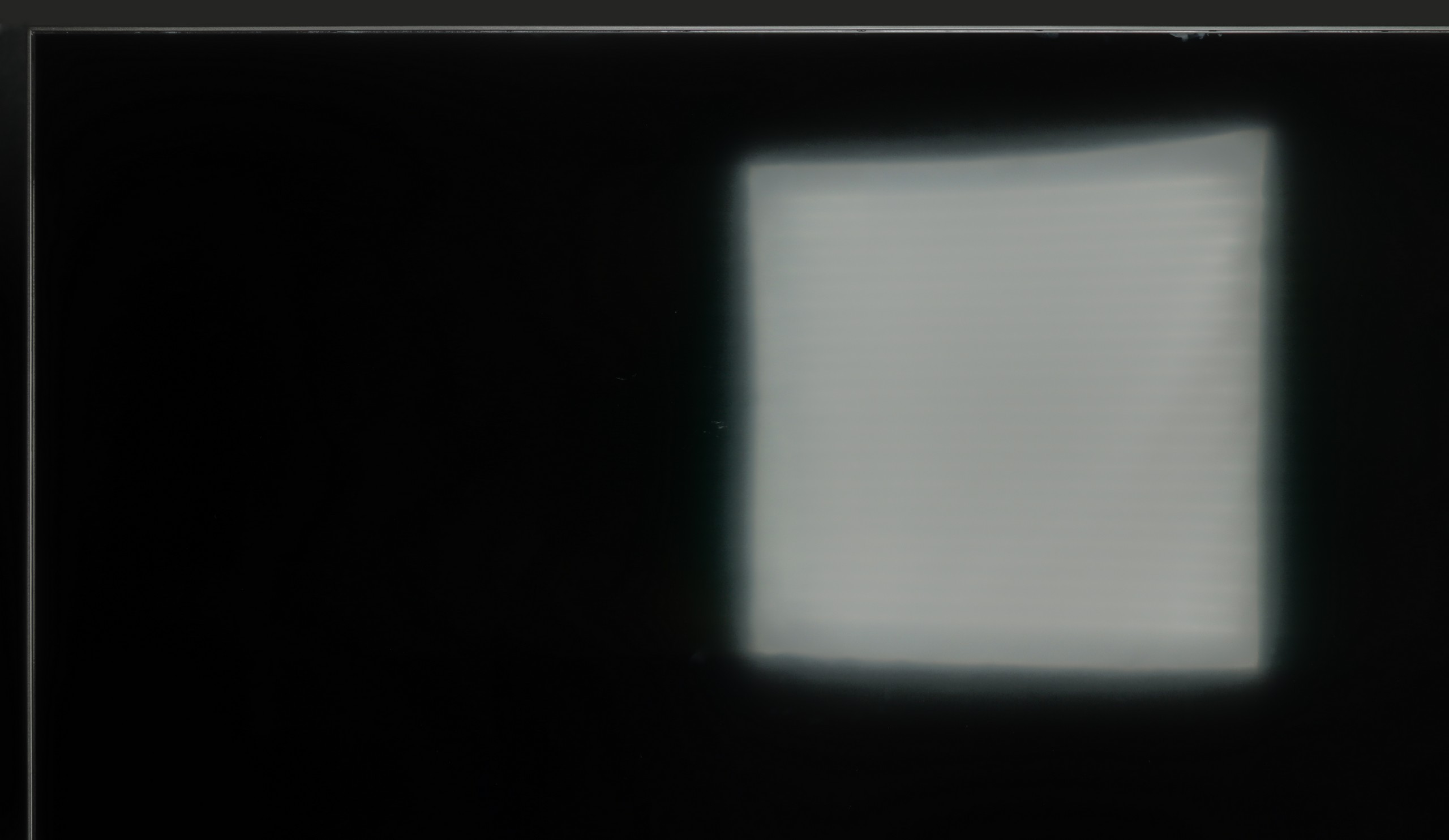


Matrix brightness
Average luminance SDR
PHILPS PUS9060: 495 cd/m2
TCL P755: 290 cd/m2
The TV, equipped with a satin finish, performs well in moderately lit daytime conditions. Its brightness in SDR mode is around 290 nits, which is an average value. Unfortunately, the television has poor reflection handling, meaning that reflections of light can be noticeable, especially in bright surroundings. Nevertheless, the television offers good black levels during the day, due to the use of a VA panel, which handles contrast better compared to IPS panels. In practice, this means that despite issues with reflections, the television can deliver a satisfying picture in daytime conditions, maintaining a decent level of black and contrast.
The Philips PUS9060 performs quite well in a bright room. The satin finish of the panel effectively reduces reflections and glare, so watching in a room full of lamps or with large windows should not pose major problems. It's also a plus that the blacks do not wash out excessively, and the picture still retains decent contrast. The situation could be even better if the television offered higher brightness. About 500 nits is a decent result, but in very challenging lighting conditions, it may prove insufficient.
Details about the matrix
Subpixel Structure:

Panel uniformity:


TV features
7.7/10
6.4/10
- HDMI inputs3 x HDMI 2.0, 0 x HDMI 2.10 x HDMI 2.0, 4 x HDMI 2.1 48Gbps
- Other inputsRCA (Chinch)Toslink (Optical audio)
- OutputsToslink (Optical audio), eARC (HDMI), ARC (HDMI)Toslink (Optical audio), eARC (HDMI), ARC (HDMI), Mini-Jack (Headphones)
- Network InterfacesWi-Fi 2.4GHz, Wi-Fi 5GHz, Ethernet (LAN) 100MbpsWi-Fi 2.4GHz, Wi-Fi 5GHz, Ethernet (LAN) 100Mbps
- TV receptionDVB-T, DVB-T2, DVB-S, DVB-S2, DVB-CDVB-T, DVB-T2, DVB-S, DVB-S2, DVB-C
Classic features:
- Recording to USB (terrestrial TV)
- Recording programming
- Picture in Picture (PiP)
- RF remote control (no need to aim at the screen)
- Backlit remote control
- Teletext
- Audio only mode
- Possibility to connect Bluetooth headphones to the TV
- Possibility to simultaneously use Bluetooth headphones and the TV speaker
Smart features:
- AirPlay
- Screen mirroring (Windows Miracast)
- Wyszukiwanie głosowe
- Voice search in native language
- Ability to connect a keyboard and mouse


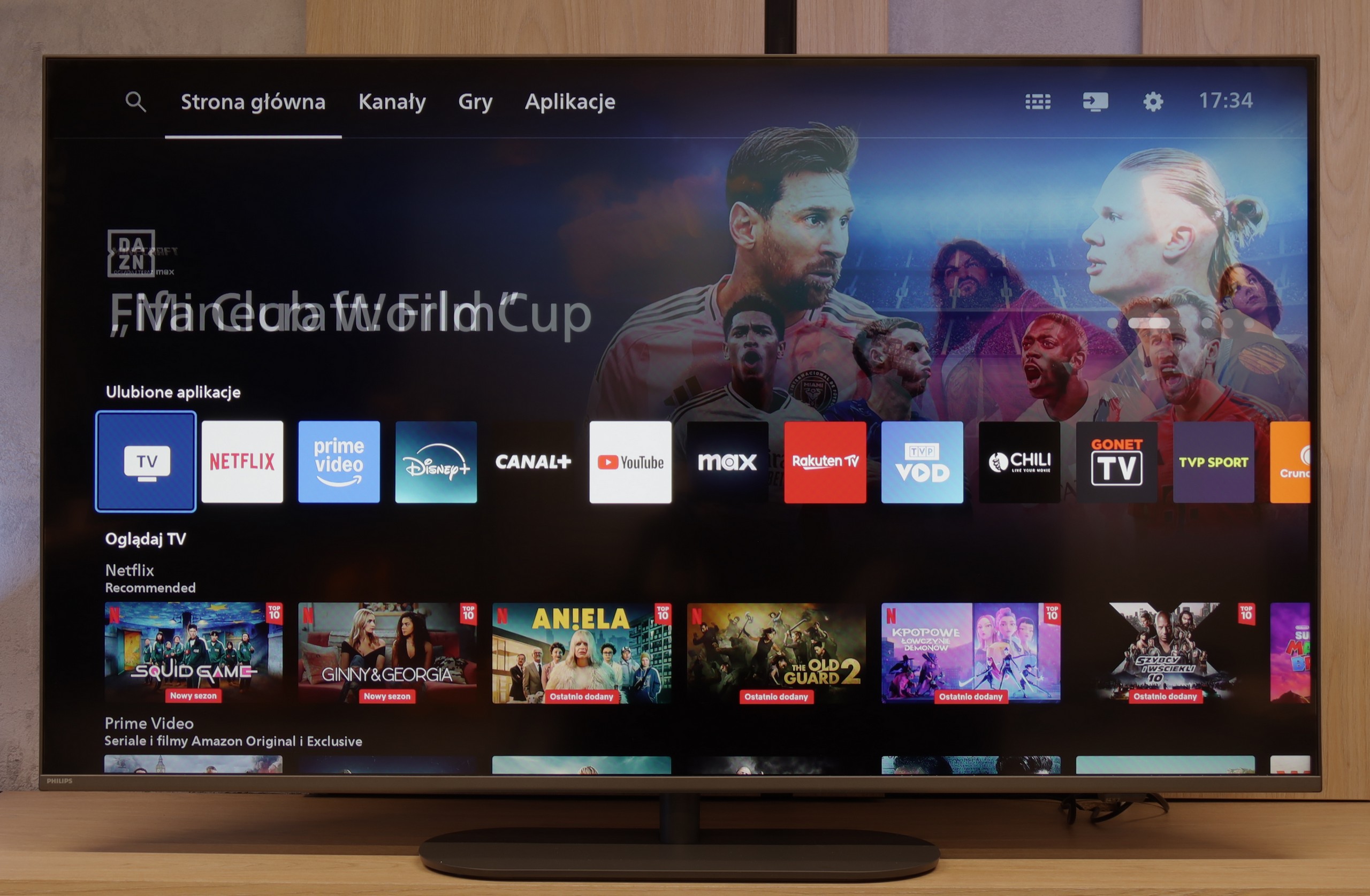
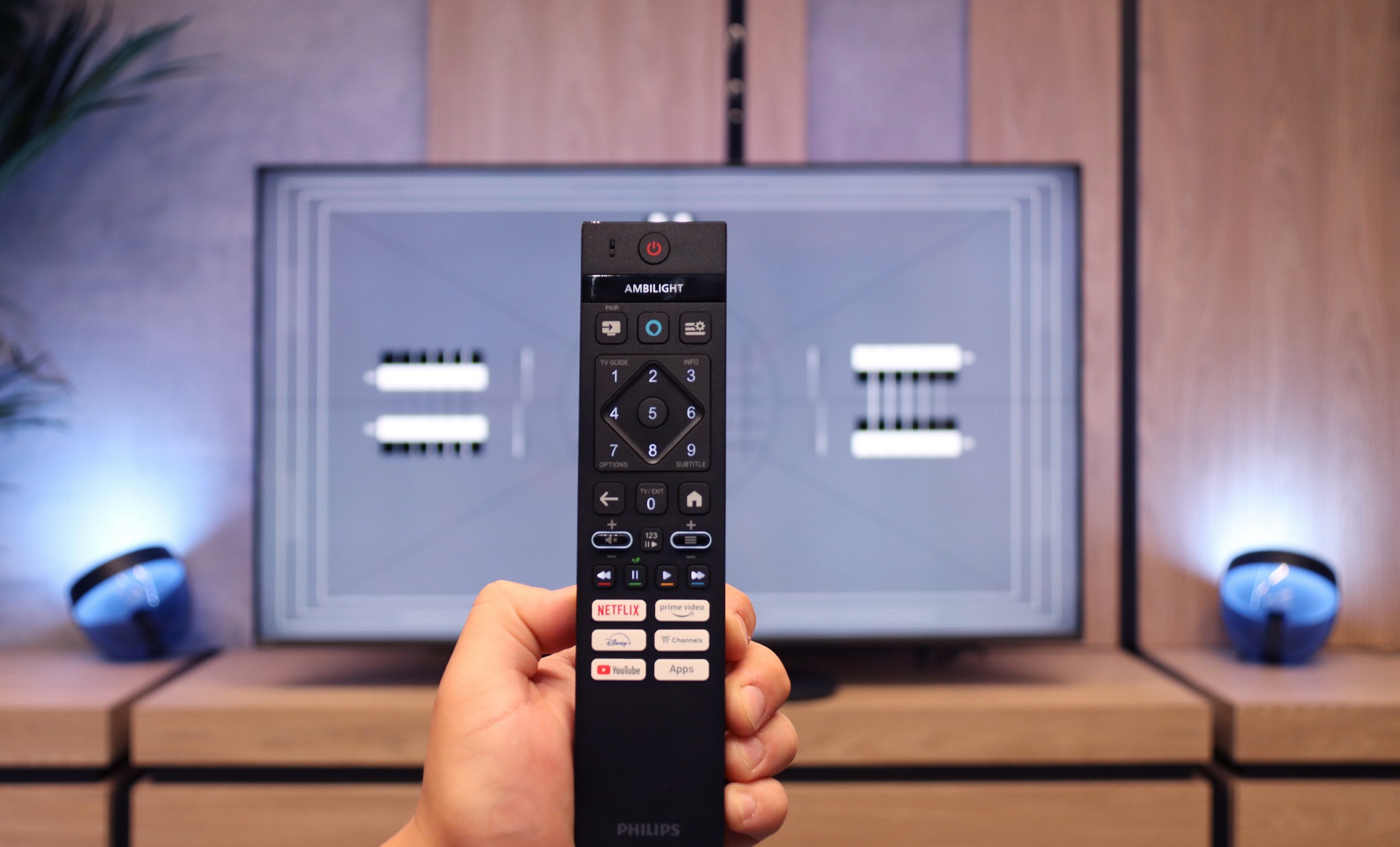

The device operates on the Google TV system, offering a wide range of features that enhance user comfort. Google TV, an extension of Android TV, provides personalised content recommendations based on watched programmes and user preferences. It allows easy access to popular streaming applications such as Netflix, YouTube, and Prime Video, as well as integration with the Google Play Store for additional apps. The system works with other Google devices, enabling control of the television using Google Assistant and integration with a smart home system.
In terms of connectivity, the television supports screen mirroring via Windows Miracast and AirPlay, allowing easy transmission of images from other devices. It also allows connection of a keyboard, mouse, and Bluetooth headphones, while simultaneously using headphones and the built-in speaker with separate volume control for both audio sources. The television remote operates on an RF basis, so there is no need to aim at the screen, although it is not backlit. Additionally, the television supports audio-only mode and teletext, although it lacks picture-in-picture (PiP) functionality.
Classic Features of TheOne TV:
When it comes to these "classic features," the PUS9060 performs quite mediocrely. Of course, we will find everything basic here; there's EPG, teletext, and the ability to connect headphones via Bluetooth. But unfortunately – it lacks the USB recording function, and there's no PiP (picture in picture) mode, which is becoming rarer but is still useful. On the plus side, the remote control with a numeric keypad is modern, backlit, and visually impressive. It's just a shame that it's still a classic infrared model, so to use it, you have to aim it directly at the screen. It's a bit disappointing because with such a modern appearance, it really called for Bluetooth (RF) control.
Smart TV:
Most Philips TVs from 2025 operate on the Titan OS system, which debuted relatively recently – and unfortunately, this still comes with certain problems. The system itself runs quite smoothly – definitely better than in cheaper Philips models – and it did not cause us issues when using features like screen mirroring or AirPlay (which is not so obvious even in 2025). The biggest downside of Titan OS is still the rather mediocre access to applications (list below). The advantage is that we can bypass this by connecting a keyboard and mouse to the TV and using the built-in browser, but it's not the most comfortable solution – rather a makeshift one.
Playing files from USB
9.1/10
7.9/10
Supported photo formats:
Maximum photo resolution:


The television will play most files and video codecs, and with subtitles uploaded for the film, you can change the font size. The biggest downside here is the lack of support for less popular photo formats.
The built-in player in the PUS9060 played practically most popular audio and video formats, so it's really hard to find fault here. Movies in popular containers, music, and photos – everything worked without any problems.
The only potential drawback might be the limited number of supported subtitle formats and the randomly selected photo resolutions that the television can read. But aside from that, most everyday users will be perfectly fine without the need to connect a computer or console to display their files from a pen drive.
Apps
9.6/10
6.2/10














































Sound
5.8/10
6.6/10
- Subjective sound quality:5.8/106.6/10
- Dolby Digital Plus 7.1:
- Dolby True HD 7.1:
- Dolby Atmos in Dolby Digital Plus (JOC):
- Dolby Atmos in Dolby True HD:
- DTS:X in DTS-HD MA:
- DTS-HD Master Audio:
The sound quality in the television is rather average. The high tones are slightly distorted and can sound unclear, while the bass is almost non-existent. The sound is dominated by the mid tones, which makes the overall audio experience balanced, but lacking in fullness. On the plus side, it supports advanced audio codecs such as Dolby and DTS, improving compatibility with various audio sources and formats.
The sound from the PHILIPS PUS9060 was generally pleasant, although it is hard to call it sensational. The tested unit had built-in audio in a 2.0 configuration with a total power of 40 W, which is entirely sufficient for everyday viewing. Fortunately, the television supports most popular audio formats, so if someone connects a soundbar or home cinema, they can confidently expect full support for Dolby Atmos or DTS – without any hassle or loss of quality. For true audio fans, this is definitely good news.


